load capacity SUBARU FORESTER 2007 SG / 2.G Owners Manual
[x] Cancel search | Manufacturer: SUBARU, Model Year: 2007, Model line: FORESTER, Model: SUBARU FORESTER 2007 SG / 2.GPages: 356, PDF Size: 5.89 MB
Page 194 of 356
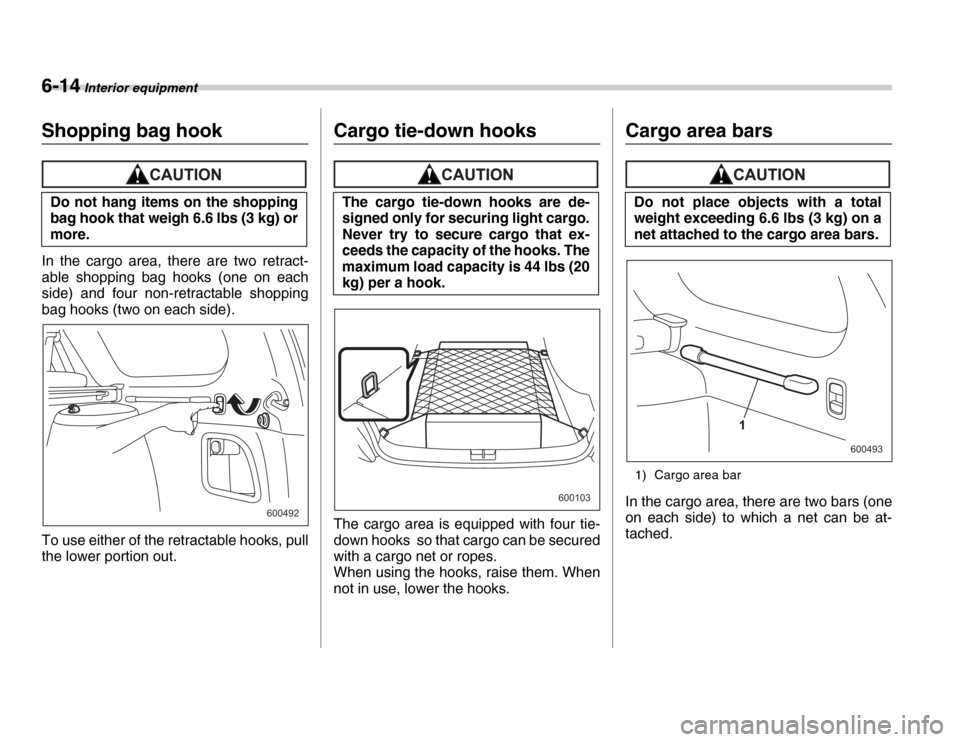
6-14 Interior equipment
Shopping bag hook
In the cargo area, there are two retract-
able shopping bag hooks (one on each
side) and four non-retractable shopping
bag hooks (two on each side).
To use either of the retractable hooks, pull
the lower portion out.
Cargo tie-down hooks
The cargo area is equipped with four tie-
down hooks so that cargo can be secured
with a cargo net or ropes.
When using the hooks, raise them. When
not in use, lower the hooks.
Cargo area bars
1) Cargo area bar
In the cargo area, there are two bars (one
on each side) to which a net can be at-
tached.
Do not hang items on the shopping
bag hook that weigh 6.6 lbs (3 kg) or
more.
600492
The cargo tie-down hooks are de-
signed only for securing light cargo.
Never try to secure cargo that ex-
ceeds the capacity of the hooks. The
maximum load capacity is 44 lbs (20
kg) per a hook.
600103
Do not place objects with a total
weight exceeding 6.6 lbs (3 kg) on a
net attached to the cargo area bars.
1
600493
Page 225 of 356

8
Driving tips
New vehicle break-in driving – the first 1,000 miles (1,600 km) .................................... 8-2
Fuel economy hints ........................................... 8-2
Engine exhaust gas (Carbon monoxide) ........ 8-2
Catalytic converter ............................................. 8-3
Periodic inspections .......................................... 8-4
Driving in foreign countries .............................. 8-4
Driving tips for AWD vehicles ........................... 8-5
Off road driving .................................................. 8-6
Winter driving ..................................................... 8-7 Operation during cold weather .............................. 8-7
Driving on snowy and icy roads ............................ 8-9
Corrosion protection .............................................. 8-10
Snow tires ............................................................... 8-10
Tire chains ............................................................... 8-10
Rocking the vehicle ................................................ 8-11
Loading your vehicle ......................................... 8-11 Vehicle capacity weight ......................................... 8-12
GVWR and GAWR (Gross Vehicle Weight Rating and Gross Axle Weight Rating) ........................... 8-12
Roof rail and crossbar (if equipped) ..................... 8-13
Trailer hitch (if equipped) .................................. 8-16 Connecting a trailer ................................................ 8-16
When you do not tow a trailer ............................... 8-17
Trailer towing ...................................................... 8-18 Warranties and maintenance ................................. 8-18
Maximum load limits .............................................. 8-18 Trailer hitches ......................................................... 8-21
Connecting a trailer ................................................ 8-22
Trailer towing tips ................................................... 8-23
Page 231 of 356
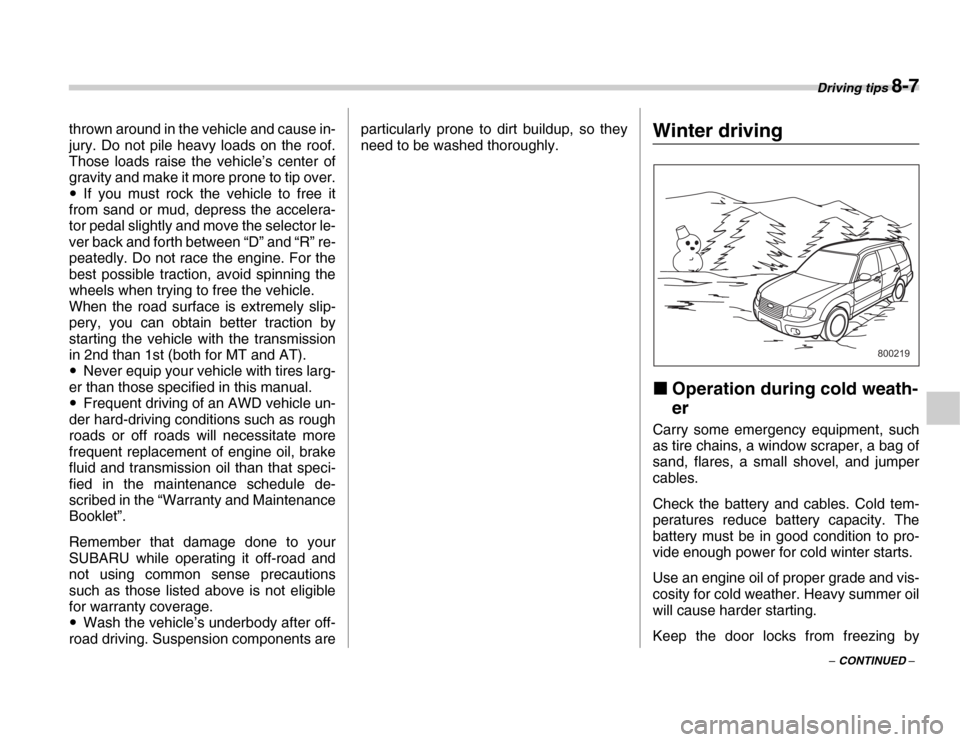
Driving tips 8-7
– CONTINUED –
thrown around in the vehicle and cause in-
jury. Do not pile heavy loads on the roof.
Those loads raise the vehicle’s center of
gravity and make it more prone to tip over. �y
If you must rock the vehicle to free it
from sand or mud, depress the accelera-
tor pedal slightly and move the selector le-
ver back and forth between “D” and “R” re-
peatedly. Do not race the engine. For the
best possible traction, avoid spinning the
wheels when trying to free the vehicle.
When the road surface is extremely slip-
pery, you can obtain better traction by
starting the vehicle with the transmission
in 2nd than 1st (both for MT and AT). �y Never equip your vehicle with tires larg-
er than those specified in this manual.�y Frequent driving of an AWD vehicle un-
der hard-driving conditions such as rough
roads or off roads will necessitate more
frequent replacement of engine oil, brake
fluid and transmission oil than that speci-
fied in the maintenance schedule de-
scribed in the “Warranty and Maintenance
Booklet”.
Remember that damage done to your
SUBARU while operating it off-road and
not using common sense precautions
such as those listed above is not eligible
for warranty coverage.�y Wash the vehicle’s underbody after off-
road driving. Suspension components are particularly prone to dirt buildup, so they
need to be washed thoroughly.
Winter driving �„
Operation during cold weath- er
Carry some emergency equipment, such
as tire chains, a window scraper, a bag of
sand, flares, a small shovel, and jumper
cables.
Check the battery and cables. Cold tem-
peratures reduce battery capacity. The
battery must be in good condition to pro-
vide enough power for cold winter starts.
Use an engine oil of proper grade and vis-
cosity for cold weather. Heavy summer oil
will cause harder starting.
Keep the door locks from freezing by
800219
Page 236 of 356
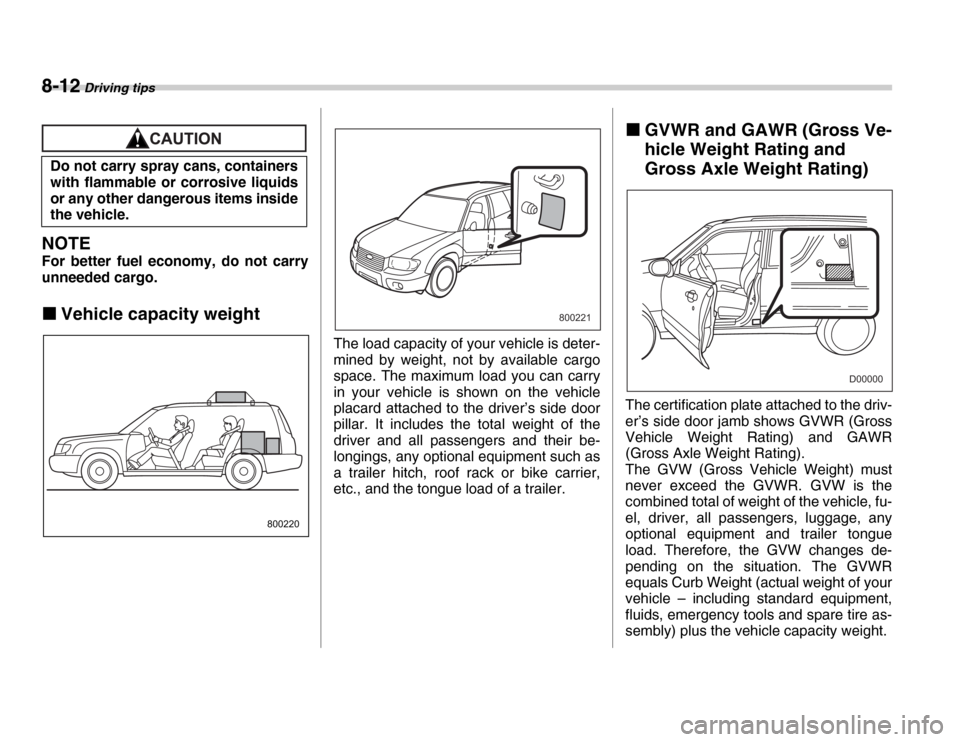
8-12 Driving tips
NOTE
For better fuel economy, do not carry
unneeded cargo. �„ Vehicle capacity weight
The load capacity of your vehicle is deter-
mined by weight, not by available cargo
space. The maximum load you can carry
in your vehicle is shown on the vehicle
placard attached to the driver’s side door
pillar. It includes the total weight of the
driver and all passengers and their be-
longings, any optional equipment such as
a trailer hitch, roof rack or bike carrier,
etc., and the tongue load of a trailer. �„
GVWR and GAWR (Gross Ve-
hicle Weight Rating and
Gross Axle Weight Rating)
The certification plate attached to the driv-
er’s side door jamb shows GVWR (Gross
Vehicle Weight Rating) and GAWR
(Gross Axle Weight Rating).
The GVW (Gross Vehicle Weight) must
never exceed the GVWR. GVW is the
combined total of weight of the vehicle, fu-
el, driver, all passengers, luggage, any
optional equipment and trailer tongue
load. Therefore, the GVW changes de-
pending on the situation. The GVWR
equals Curb Weight (actual weight of your
vehicle – including standard equipment,
fluids, emergency tools and spare tire as-
sembly) plus the vehicle capacity weight.
Do not carry spray cans, containers
with flammable or corrosive liquids
or any other dangerous items inside
the vehicle.
800220
800221
D00000
Page 237 of 356
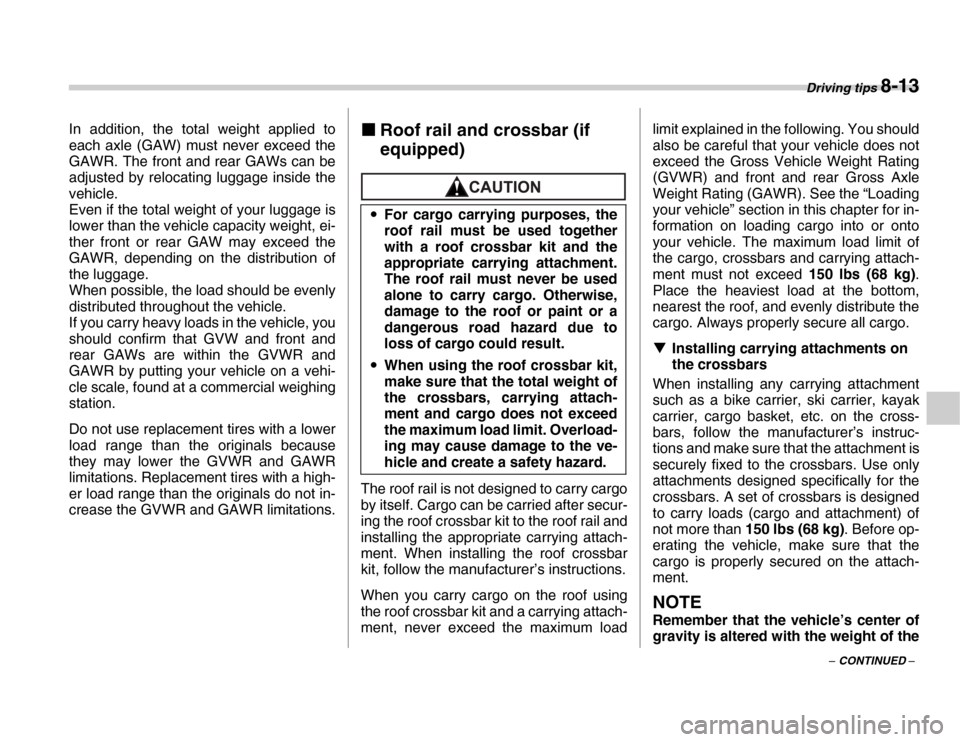
Driving tips 8-13
– CONTINUED –
In addition, the total weight applied to
each axle (GAW) must never exceed the
GAWR. The front and rear GAWs can be
adjusted by relocating luggage inside the
vehicle.
Even if the total weight of your luggage is
lower than the vehicle capacity weight, ei-
ther front or rear GAW may exceed the
GAWR, depending on the distribution of
the luggage.
When possible, the load should be evenly
distributed throughout the vehicle.
If you carry heavy loads in the vehicle, you
should confirm that GVW and front and
rear GAWs are within the GVWR and
GAWR by putting your vehicle on a vehi-
cle scale, found at a commercial weighing
station.
Do not use replacement tires with a lower
load range than the originals because
they may lower the GVWR and GAWR
limitations. Replacement tires with a high-
er load range than the originals do not in-
crease the GVWR and GAWR limitations.
�„
Roof rail and crossbar (if
equipped)
The roof rail is not designed to carry cargo
by itself. Cargo can be carried after secur-
ing the roof crossbar kit to the roof rail and
installing the appropriate carrying attach-
ment. When installing the roof crossbar
kit, follow the manufacturer’s instructions.
When you carry cargo on the roof using
the roof crossbar kit and a carrying attach-
ment, never exceed the maximum load limit explained in the following. You should
also be careful that your vehicle does not
exceed the Gross Vehicle Weight Rating
(GVWR) and front and rear Gross Axle
Weight Rating (GAWR). See the “Loading
your vehicle” section in this chapter for in-
formation on loading cargo into or onto
your vehicle. The maximum load limit of
the cargo, crossbars and carrying attach-
ment must not exceed
150 lbs (68 kg).
Place the heaviest load at the bottom,
nearest the roof, and evenly distribute the
cargo. Always properly secure all cargo. �T Installing carrying attachments on
the crossbars
When installing any carrying attachment
such as a bike carrier, ski carrier, kayak
carrier, cargo basket, etc. on the cross-
bars, follow the manufacturer’s instruc-
tions and make sure that the attachment is
securely fixed to the crossbars. Use only
attachments designed specifically for the
crossbars. A set of crossbars is designed
to carry loads (cargo and attachment) of
not more than 150 lbs (68 kg) . Before op-
erating the vehicle, make sure that the
cargo is properly secured on the attach-
ment.
NOTE
Remember that the vehicle’s center of
gravity is altered with the weight of the
�y
For cargo carrying purposes, the
roof rail must be used together
with a roof crossbar kit and the
appropriate carrying attachment.
The roof rail must never be used
alone to carry cargo. Otherwise,
damage to the roof or paint or a
dangerous road hazard due to
loss of cargo could result.
�y When using the roof crossbar kit,
make sure that the total weight of
the crossbars, carrying attach-
ment and cargo does not exceed
the maximum load limit. Overload-
ing may cause damage to the ve-
hicle and create a safety hazard.
Page 247 of 356
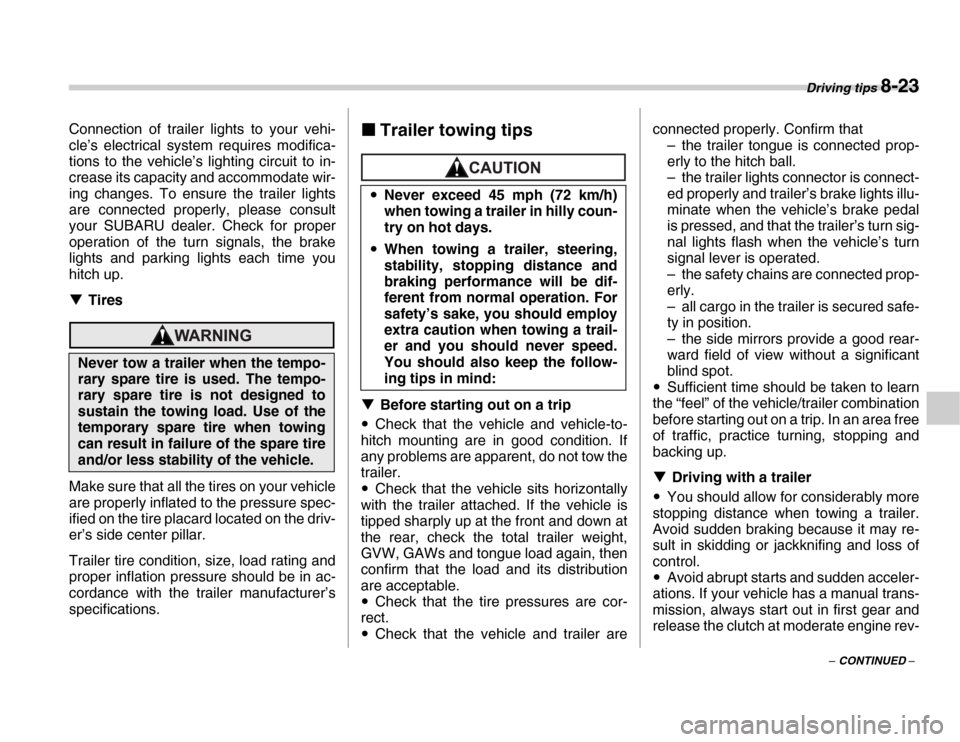
Driving tips 8-23
– CONTINUED –
Connection of trailer lights to your vehi-
cle’s electrical system requires modifica-
tions to the vehicle’s lighting circuit to in-
crease its capacity and accommodate wir-
ing changes. To ensure the trailer lights
are connected properly, please consult
your SUBARU dealer. Check for proper
operation of the turn signals, the brake
lights and parking lights each time you
hitch up. �T
Tires
Make sure that all the tires on your vehicle
are properly inflated to the pressure spec-
ified on the tire placard located on the driv-
er’s side center pillar.
Trailer tire condition, size, load rating and
proper inflation pressure should be in ac-
cordance with the trailer manufacturer’s
specifications. �„
Trailer towing tips
�TBefore starting out on a trip
�y Check that the vehicle and vehicle-to-
hitch mounting are in good condition. If
any problems are apparent, do not tow the
trailer. �y Check that the vehicle sits horizontally
with the trailer attached. If the vehicle is
tipped sharply up at the front and down at
the rear, check the total trailer weight,
GVW, GAWs and tongue load again, then
confirm that the load and its distribution
are acceptable. �y Check that the tire pressures are cor-
rect. �y Check that the vehicle and trailer are connected properly. Confirm that
– the trailer tongue is connected prop-
erly to the hitch ball.
– the trailer lights connector is connect-
ed properly and trailer’s brake lights illu-
minate when the vehicle’s brake pedal
is pressed, and that the trailer’s turn sig-
nal lights flash when the vehicle’s turn
signal lever is operated.
– the safety chains are connected prop-
erly.
– all cargo in the trailer is secured safe-
ty in position.
– the side mirrors provide a good rear-
ward field of view without a significant
blind spot.
�y Sufficient time should be taken to learn
the “feel” of the vehicle/trailer combination
before starting out on a trip. In an area free
of traffic, practice turning, stopping and
backing up. �T Driving with a trailer
�y You should allow for considerably more
stopping distance when towing a trailer.
Avoid sudden braking because it may re-
sult in skidding or jackknifing and loss of
control. �y Avoid abrupt starts and sudden acceler-
ations. If your vehicle has a manual trans-
mission, always start out in first gear and
release the clutch at moderate engine rev-
Never tow a trailer when the tempo-
rary spare tire is used. The tempo-
rary spare tire is not designed to
sustain the towing load. Use of the
temporary spare tire when towing
can result in failure of the spare tire
and/or less stability of the vehicle.
�y Never exceed 45 mph (72 km/h)
when towing a trailer in hilly coun-
try on hot days.
�y When towing a trailer, steering,
stability, stopping distance and
braking performance will be dif-
ferent from normal operation. For
safety’s sake, you should employ
extra caution when towing a trail-
er and you should never speed.
You should also keep the follow-
ing tips in mind:
Page 338 of 356
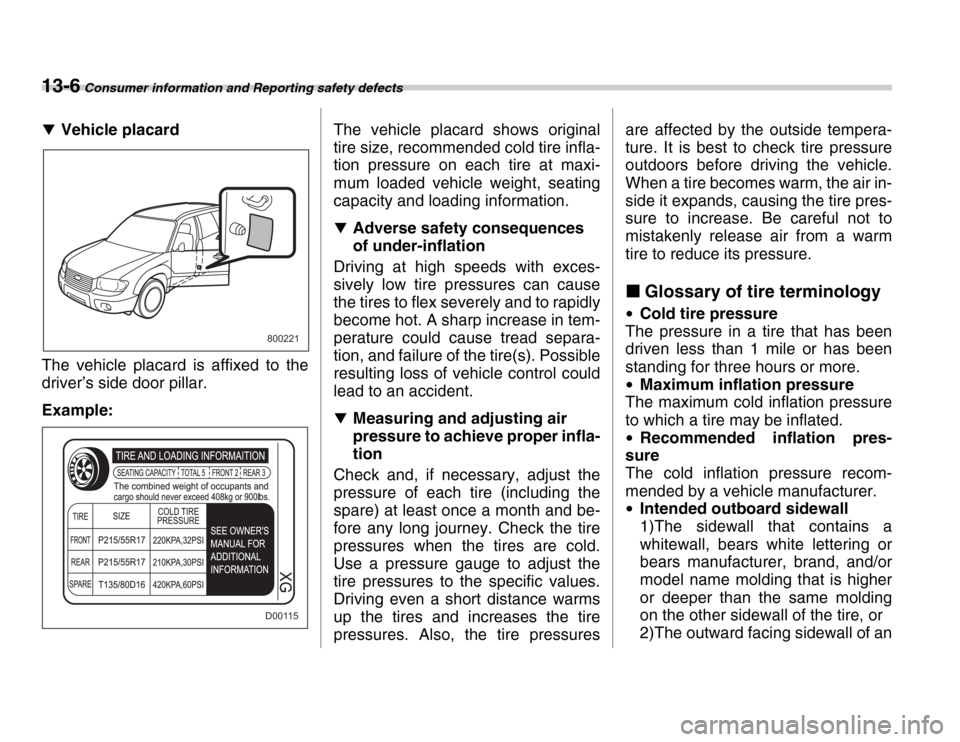
13-6 Consumer information and Reporting safety defects
�TVehicle placard
The vehicle placard is affixed to the
driver’s side door pillar.
Example: The vehicle placard shows original
tire size, recommended cold tire infla-
tion pressure on each tire at maxi-
mum loaded vehicle weight, seating
capacity and loading information.
�T Adverse safety consequences
of under-inflation
Driving at high speeds with exces-
sively low tire pressures can cause
the tires to flex severely and to rapidly
become hot. A sharp increase in tem-
perature could cause tread separa-
tion, and failure of the tire(s). Possible
resulting loss of vehicle control could
lead to an accident. �T Measuring and adjusting air
pressure to achieve proper infla- tion
Check and, if necessary, adjust the
pressure of each tire (including the
spare) at least once a month and be-
fore any long journey. Check the tire
pressures when the tires are cold.
Use a pressure gauge to adjust the
tire pressures to the specific values.
Driving even a short distance warms
up the tires and increases the tire
pressures. Also, the tire pressures are affected by the outside tempera-
ture. It is best to check tire pressure
outdoors before driving the vehicle.
When a tire becomes warm, the air in-
side it expands, causing the tire pres-
sure to increase. Be careful not to
mistakenly release air from a warm
tire to reduce its pressure.
�„ Glossary of tire terminology
�y Cold tire pressure
The pressure in a tire that has been
driven less than 1 mile or has been
standing for three hours or more. �y Maximum inflation pressure
The maximum cold inflation pressure
to which a tire may be inflated. �y Recommended inflation pres-
sure
The cold inflation pressure recom-
mended by a vehicle manufacturer. �y Intended outboard sidewall
1)The sidewall that contains a
whitewall, bears white lettering or
bears manufacturer, brand, and/or
model name molding that is higher
or deeper than the same molding
on the other sidewall of the tire, or
2)The outward facing sidewall of an
800221
D00115
Page 339 of 356

Consumer information and Reporting safety defects 13-7
– CONTINUED –
asymmetrical tire that has a particu-
lar side that must always face out-
ward when mounting on a vehicle.
�y Accessory weight
The combined weight (in excess of
those standard items which may be
replaced) of floor mats, leather seats
and cross bars to the extent that these
items are available as factory-in-
stalled equipment (whether installed
or not). �y Curb weight
The weight of a motor vehicle with
standard equipment including the
maximum capacity of fuel, oil, and
coolant and air conditioning. �y Maximum loaded vehicle weight
The sum of curb weight, accessory
weight, vehicle capacity weight and
production options weight. �y Normal occupant weight
150 lbs (68 kg) times the number of
occupants (3 occupants). �y Occupant distribution
Distribution of occupants in a vehicle,
2 in front, 1 in rear seat. �y Production options weight
The combined weight of those in-
stalled regular production options weighing over 5.1 lbs (2.3 kg) in ex-
cess of those standards items which
they replace, not previously consid-
ered in curb weight or accessory
weight.
�y Vehicle capacity weight
The total weight of cargo, luggage
and occupants that can be added to
the vehicle. �y Vehicle maximum load on a tire
Load on an individual tire that is deter-
mined by distributing to each axle its
share of the maximum loaded vehicle
weight and dividing by two. �y Vehicle normal load on a tire
Load on an individual tire that is deter-
mined by distributing to each axle its
share of the curb weight, accessory
weight, and normal occupant weight
and dividing by two. �„ Tire care – maintenance and
safety practices
�y Check on a daily basis that the tires
are free from serious damage, nails,
and stones. At the same time, check
the tires for abnormal wear. �y Inspect the tire tread regularly and
replace the tires before their tread wear indicators become visible. When
a tire’s tread wear indicator becomes
visible, the tire is worn beyond the ac-
ceptable limit and must be replaced
immediately. With a tire in this condi-
tion, driving at even low speeds in wet
weather can cause the vehicle to hy-
droplane. Possible resulting loss of
vehicle control can lead to an acci-
dent.
�y To maximize the life of each tire and
ensure that the tires wear uniformly, it
is best to rotate the tires every 7,500
miles (12,500 km). Rotating the tires
involves switching the front and rear
tires on the right-hand side of the ve-
hicle and similarly switching the front
and rear tires on the left-hand side of
the vehicle. (Each tire must be kept on
its original side of the vehicle.) Re-
place any damaged or unevenly worn
tire at the time of rotation. After tire ro-
tation, adjust the tire pressures and
make sure the wheel nuts are correct-
ly tightened. A tightening torque spec-
ification and a tightening sequence
specification for the wheel nuts can be
found “Flat tires” in Chapter 9.
Page 340 of 356
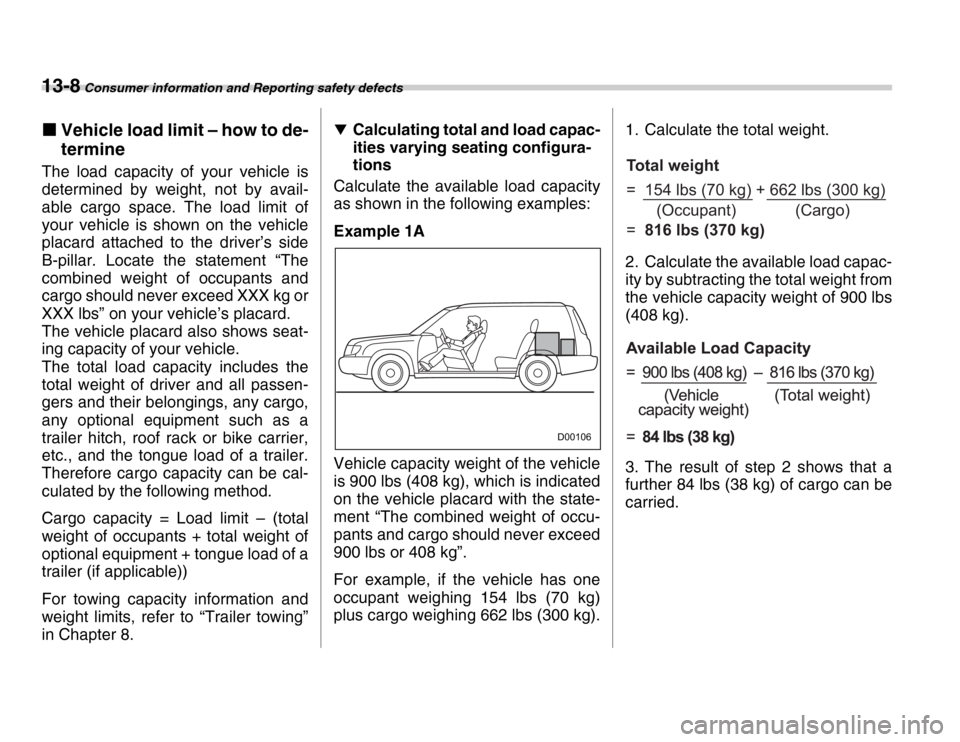
13-8 Consumer information and Reporting safety defects
�„Vehicle load limit – how to de-
termine
The load capacity of your vehicle is
determined by weight, not by avail-
able cargo space. The load limit of
your vehicle is shown on the vehicle
placard attached to the driver’s side
B-pillar. Locate the statement “The
combined weight of occupants and
cargo should never exceed XXX kg or
XXX lbs” on your vehicle’s placard.
The vehicle placard also shows seat-
ing capacity of your vehicle.
The total load capacity includes the
total weight of driver and all passen-
gers and their belongings, any cargo,
any optional equipment such as a
trailer hitch, roof rack or bike carrier,
etc., and the tongue load of a trailer.
Therefore cargo capacity can be cal-
culated by the following method.
Cargo capacity = Load limit – (total
weight of occupants + total weight of
optional equipment + tongue load of a
trailer (if applicable))
For towing capacity information and
weight limits, refer to “Trailer towing”
in Chapter 8. �T
Calculating total and load capac-
ities varying seating configura- tions
Calculate the available load capacity
as shown in the following examples:
Example 1A
Vehicle capacity weight of the vehicle
is 900 lbs (408 kg), which is indicated
on the vehicle placard with the state-
ment “The combined weight of occu-
pants and cargo should never exceed
900 lbs or 408 kg”.
For example, if the vehicle has one
occupant weighing 154 lbs (70 kg)
plus cargo weighing 662 lbs (300 kg). 1. Calculate the total weight.
2. Calculate the available load capac-
ity by subtracting the total weight from
the vehicle capacity weight of 900 lbs
(408 kg).
3. The result of step 2 shows that a
further 84 lbs (38 kg) of cargo can be
carried.
D00106
Total weight = 154 lbs (70 kg) + 662 lbs (300 kg) =
816 lbs (370 kg)(Occupant) (Cargo)
Page 341 of 356
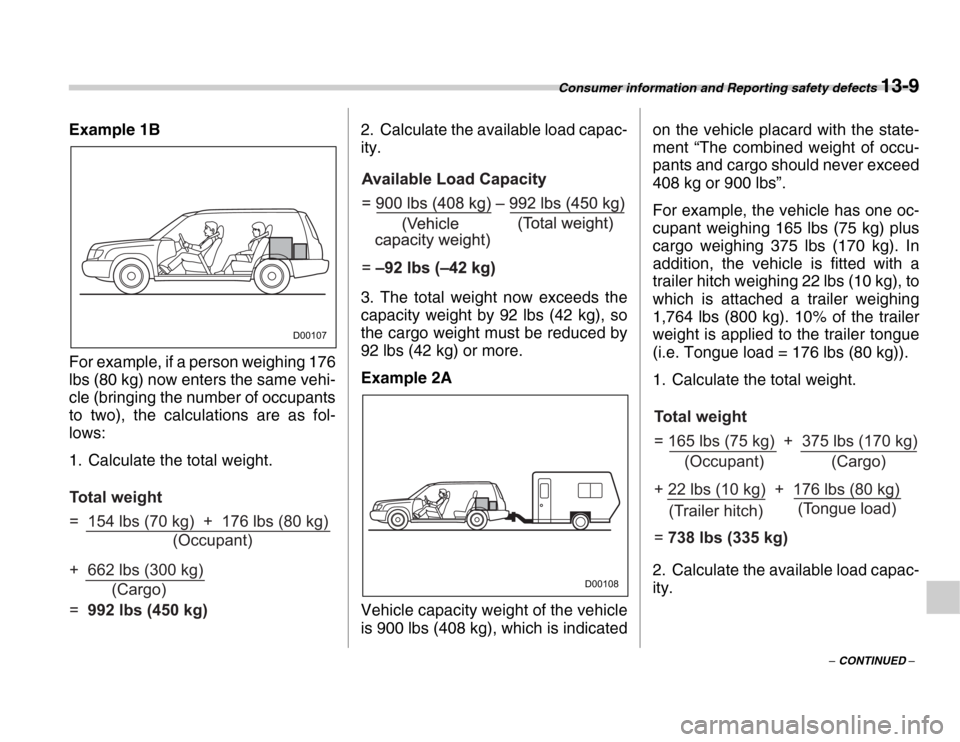
Consumer information and Reporting safety defects 13-9
– CONTINUED –
Example 1B
For example, if a person weighing 176
lbs (80 kg) now enters the same vehi-
cle (bringing the number of occupants
to two), the calculations are as fol-
lows:
1. Calculate the total weight.
2. Calculate the available load capac-
ity.
3. The total weight now exceeds the
capacity weight by 92 lbs (42 kg), so
the cargo weight must be reduced by
92 lbs (42 kg) or more.
Example 2A
Vehicle capacity weight of the vehicle
is 900 lbs (408 kg), which is indicated on the vehicle placard with the state-
ment “The combined weight of occu-
pants and cargo should never exceed
408 kg or 900 lbs”.
For example, the vehicle has one oc-
cupant weighing 165 lbs (75 kg) plus
cargo weighing 375 lbs (170 kg). In
addition, the vehicle is fitted with a
trailer hitch weighing 22 lbs (10 kg), to
which is attached a trailer weighing
1,764 lbs (800 kg). 10% of the trailer
weight is applied to the trailer tongue
(i.e. Tongue load = 176 lbs (80 kg)).
1. Calculate the total weight.
2. Calculate the available load capac-
ity.
D00107
Total weight = 154 lbs (70 kg) + 176 lbs (80 kg) + 662 lbs (300 kg) =
992 lbs (450 kg) (Occupant)
(Cargo)
D00108
Total weight = 165 lbs (75 kg) + 375 lbs (170 kg) + 22 lbs (10 kg) + 176 lbs (80 kg)= 738 lbs (335 kg) (Occupant) (Cargo)
(Trailer hitch) (Tongue load)